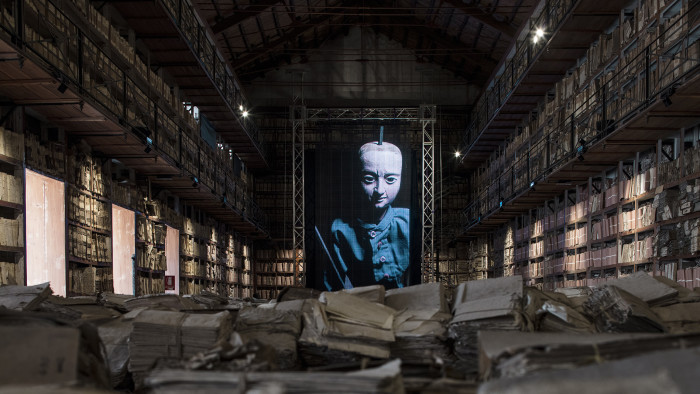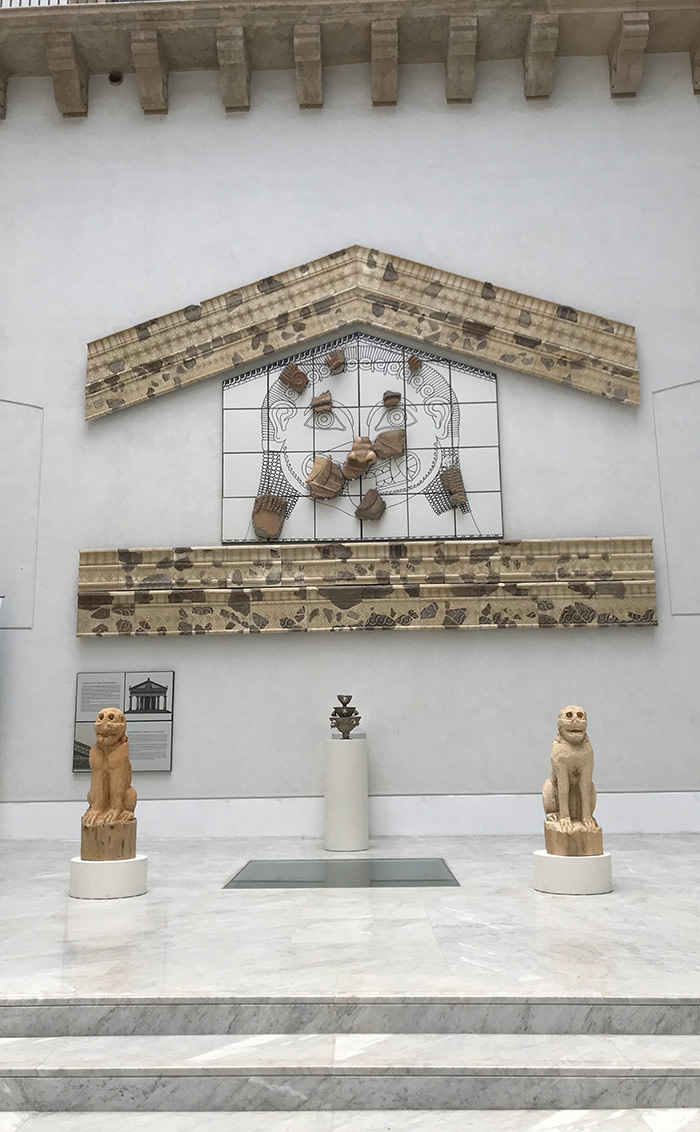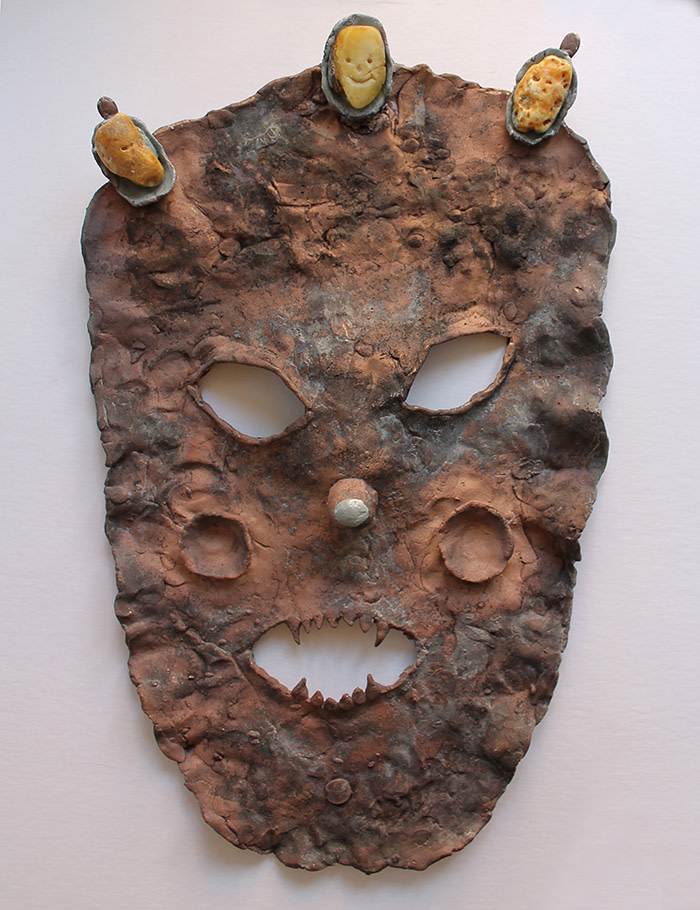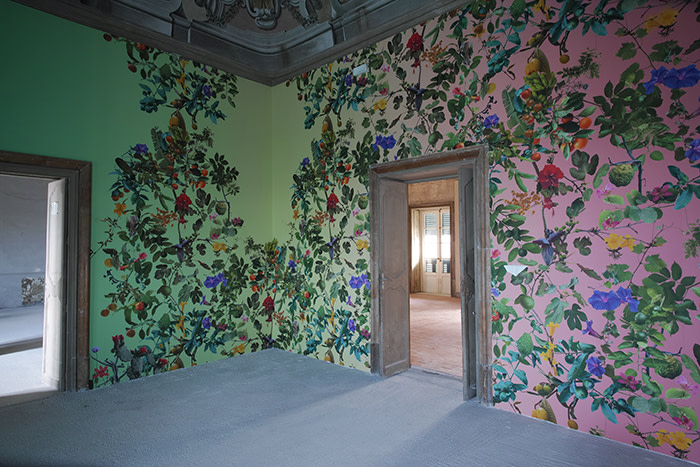Manifesta 12: The world’s fair

Simply sign up to the Life & Arts myFT Digest -- delivered directly to your inbox.
On the stone façade of Palazzo Chiaramonte in Palermo, there are grooves left by the iron cages in which hung the severed heads of aristocrat rebels against Emperor Charles V. The fortified palace near the port was built in 1307 for a Sicilian lord who made his fortune collecting taxes there. Later, under Spanish rule, it became the Inquisition’s gaol; preserved against the odds on chalky walls beneath grand arches, large-scale coloured murals and scribbles — drawings of Christ’s Passion, homesick landscapes, mutterings of faith and despair — memorialise the last days of political prisoners tortured and facing death.
This is the desperately affecting context to Taiwanese artist Yahon Chang’s immersive display “Poetry of Flow”: expressive calligraphic scrolls of ghoulish heads, tumbling rivers, spiralling fronds, depicted in black oil with broad sheep-hair brushes on Italian bedsheets. It is a light, respectful intervention, directing attention as much to the ancient graffiti by victims of religious extremism as to the artist’s fusion of western and Chinese traditions. Chang mirrors too motifs in the Giardino Garibaldi opposite: huge banyans with exposed aerial roots, ornamental fountains, busts of Risorgimento leaders.
Palermo, revealing from every surface a history that spans millennia of global confrontations and cross-currents, is a perfect venue for Manifesta, Europe’s nomadic biennale committed to political art. “The Planetary Garden”, the 12th edition, launched this week, takes its title from gardener-ecologist Gilles Clément’s book suggesting that we cultivate the earth, collaboratively, as “one small garden”. An outstanding match between milieu and mindset, this Manifesta is fresh, varied, distinctive, responsive to regional Mediterranean crises yet concerned with subjects that touch us all.
Palermo’s sumptuous gardens give a seductive sense of natural abundance. In “Theatre of the Sun”, Los Angeles collective Fallen Fruit swamp a room in the decaying seaside villa Palazzo Butera with wallpaper in tropical naive style, mapping trees in public places whose lemons, oranges and apricots are available to anyone. The stunning 18th-century Orto Botanico, boasting 12,000 exotic species, those from Africa and Asia flourishing as well as at home, functions especially as a potent metaphor for thriving coexistence in this city with an ever-increasing migrant population.
At the garden’s entrance, “Palermo Herbal”, Malin Franzén’s lovely monumental “natural prints”, imitates 17th- century Sicilian botanist Paolo Boccone’s method of colour-pressing specimens, juxtaposed with today’s scientific visualisation techniques researching toxicity: a finely tuned layering of past and present echoed by several of this biennale’s most imaginative artists.

In “When Art Became Part of the Landscape” in the cloisters of the Archeological Museum Antonio Salinas, Evgeny Antufiev places delicately textured wooden and terracotta grotesques, hybrid animal-human figures, moon faces, a symbolic boat and an asymmetrical model of a temple in counterpoint to Palermo’s supreme collections of Greek sculptures, while also referencing funerary iconography and handcraft traditions in his native Siberia.
In Palazzo Costantino — a Renaissance masterpiece of overlapping loggias and double staircases that was requisitioned and wrecked by German troops, then abandoned after department store Rinascente took it on in the 1960s — Roberto Collovà evokes another wreck: photographs taken since the 1970s, flotsam and jetsam, maps and models describe “Costa Sud”, a devastated, contaminated stretch of southern Sicily’s coast.
Unmissable is the installation “Protocol no 90/6” by Masbedo — Milan-based duo Nicolò Massazza and Iacopo Bedogni — at Sala delle Capriate, a Harry Potter-like vault housing thousands of thick, dusty, uncatalogued, centuries-old volumes, piled on open shelves, aisle after aisle. On the back wall, in looped video projection, an enormous wooden marionette with piercing eyes, bewildered expression and an electric blue suit haplessly bounces towards us. His thudding, clumsy hands and feet make the only sound in the silent, mysterious archive where city records arranged by time and chance have petrified into strata of paper fossils and faded ink. Can we understand history, change it, or are we its powerless puppets?
That question plays across expansive presentations in a group of semi-ruined palaces, many seldom open to the public, all so splendid and allusive that even empty they would justify visiting this Manifesta. Palazzo Ajutamicristo, built around a courtyard of roses, fig and palm trees by a 15th-century grain trader, hosts contemporary works focused on transnational networks where everything — finance, information, fuel — is allowed to move, except people. From Algeria, Lydia Ourahmane’s “The Third Choir” is a sound installation of mobile phones amplified inside Naftal oil barrels. Rayyane Tabet’s “Steel Rings” replicates an American pipeline from Saudi Arabia to Lebanon; disused, it still runs across now impassable borders between Syria, Jordan and Lebanon.

Palazzo Forcella De Seta, a labyrinth of Moorish rooms with mosaic inlays and frescoes, stages two very effective investigative films, both by campaigners. The disturbing “Liquid Violence” by Forensic Oceanography, duo Charles Heller and Lorenzo Pezzani, traces the trajectory of migrant boats abandoned off Libya, and the political strategies making the Mediterranean a death trap. “Fluchthelfer.in. Become an Escape Agent”, by Germany’s Peng! Collective, follows Europeans returning from holidays who offer migrants lifts across borders; the video, giving voice to drivers and passengers alike, places such acts of civil disobedience in the historic spectrum of those aiding refugees from Nazism and East Germany.
Against such straightforward, gripping documentaries, over-conceptualised politicised art often looks feeble or sanctimonious. Here weak Dutch offerings particularly — Manifesta is Dutch-led — lower quality and seriousness: “Night Soil”, Melanie Bonajo’s video of women cuddling animals, played to audiences on deckchairs on sea-blue carpets, is an example.
The few big-name commissions disappoint too. For “article 11”, about US drones in Sicily, Tania Bruguera invited activists to make art works, to dreary effect. Kader Attia’s chattering cultural analysts in the long film “The Body’s Legacies. The Post Colonial Body” are infuriatingly didactic.
These are perhaps inevitable flaws in any highly political biennale. Overall, as Palermo mayor Leoluca Orlando, impassioned advocate of open borders, declared at the launch, Manifesta impressively interacts with “a city in a process of constant change . . . yesterday capital of the all-suffocating Mafia; today capital of . . . rights, peace, enterprise, mobility”. The many young black men — though, as far as I saw, no black women — among the stewards at Manifesta venues are a small symbol of change, integration, hope.

Orlando spoke in the thrillingly ornate baroque Chiesa di Santa Caterina in Piazza Bellini, around which worlds old and new, east and west, converge: Norman tower, mosque, thundering docks, migrant footballers playing on a pitch by the port while, tucked away in Palazzo Abatellis, Palermo’s “Mona Lisa”, the crystalline “Virgin Immaculate” (1476) by local hero Antonello da Messina, holds her breath, raises a hand, and asks for a moment to think.
To November 4, manifesta.org
Follow @FTLifeArts on Twitter to find out about our latest stories first. Subscribe to FT Life on YouTube for the latest FT Weekend videos
Comments